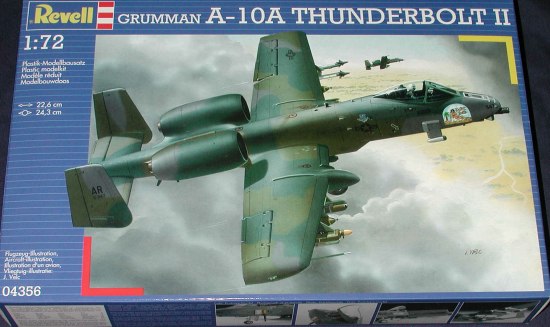
|
KIT: |
Revell AG 1/72 A-10 Thunderbolt II |
|
KIT # |
4356 |
|
PRICE: |
$20.00 MSRP |
|
DECALS: |
Two aircraft |
|
REVIEWER: |
|
|
NOTES: |
Reboxed Italeri kit. Grumman??? |

|
HISTORY |
The A/OA-10 Thunderbolt II is the first Air Force aircraft specially designed for close air support of ground forces. They are simple, effective and survivable twin-engine jet aircraft that can be used against all ground targets, including tanks and other armored vehicles.
The A-10/OA-10 have excellent maneuverability at low air speeds and altitude, and are highly accurate weapons-delivery platforms. They can loiter near battle areas for extended periods of time and operate under 1,000-foot ceilings (303.3 meters) with 1.5-mile (2.4 kilometers) visibility. Their wide combat radius and short takeoff and landing capability permit operations in and out of locations near front lines. Using night vision goggles, A-10/ OA-10 pilots can conduct their missions during darkness.
Thunderbolt IIs have Night Vision Imaging Systems (NVIS), goggle compatible single-seat cockpits forward of their wings and a large bubble canopy which provides pilots all-around vision. The pilots are protected by titanium armor that also protects parts of the flight-control system. The redundant primary structural sections allow the aircraft to enjoy better survivability during close air support than did previous aircraft.
The aircraft can survive direct hits from armor-piercing and high explosive projectiles up to 23mm. Their self-sealing fuel cells are protected by internal and external foam. Manual systems back up their redundant hydraulic flight-control systems. This permits pilots to fly and land when hydraulic power is lost.
The Thunderbolt II can be serviced and operated from bases with limited facilities near battle areas. Many of the aircraft's parts are interchangeable left and right, including the engines, main landing gear and vertical stabilizers.
Avionics equipment includes communications, inertial navigation systems, fire control and weapons delivery systems, target penetration aids and night vision goggles. Their weapons delivery systems include heads-up displays that indicate airspeed, altitude, dive angle, navigation information and weapons aiming references; a low altitude safety and targeting enhancement system (LASTE) which provides constantly computing impact point freefall ordnance delivery; and Pave Penny laser-tracking pods under the fuselage. The aircraft also have armament control panels, and infrared and electronic countermeasures to handle surface-to-air-missile threats. Installation of the Global Positioning System is currently underway for all aircraft.
The Thunderbolt II's 30mm GAU-8/A Gatling gun can fire 3,900 rounds a minute and can defeat an array of ground targets to include tanks. Some of their other equipment includes an inertial navigation system, electronic countermeasures, target penetration aids, self-protection systems, and AGM-65 Maverick and AIM-9 Sidewinder missiles.
The first production A-10A was delivered to Davis-Monthan Air Force Base, Ariz., in October 1975. It was designed specially for the close air support mission and had the ability to combine large military loads, long loiter and wide combat radius, which proved to be vital assets to the United States and its allies during Operation Desert Storm and Operation Noble Anvil. In the Gulf War, A-10s had a mission capable rate of 95.7 percent, flew 8,100 sorties and launched 90 percent of the AGM-65 Maverick missiles.
Primary Function: A-10 -- close air support, OA-10 - airborne
forward air control
Contractor: Fairchild Republic Co.
Power Plant: Two General Electric TF34-GE-100 turbofans
Thrust: 9,065 pounds each engine
Length: 53 feet, 4 inches (16.16 meters)
Height: 14 feet, 8 inches (4.42 meters)
Wingspan: 57 feet, 6 inches (17.42 meters)
Speed: 420 miles per hour (Mach 0.56)
Ceiling: 45,000 feet (13,636 meters)
Maximum Takeoff Weight: 51,000 pounds (22,950 kilograms)
Range: 800 miles (695 nautical miles)
Armament: One 30 mm GAU-8/A seven-barrel Gatling gun; up to 16,000
pounds (7,200 kilograms) of mixed ordnance on eight under-wing and three
under-fuselage pylon stations, including 500 pounds (225 kilograms) of Mk-82
and 2,000 pounds (900 kilograms) of Mk-84 series low/high drag bombs,
incendiary cluster bombs, combined effects munitions, mine dispensing
munitions, AGM-65 Maverick missiles and laser-guided/electro-optically guided
bombs; infrared countermeasure flares; electronic countermeasure chaff; jammer
pods; 2.75-inch (6.99 centimeters) rockets; illumination flares and AIM-9
Sidewinder missiles.
Crew: One
Date Deployed: March 1976
Unit Cost: $9.8 million (fiscal 98 constant dollars)
Inventory: Active force, A-10, 143 and OA-10, 70; Reserve, A-10, 46 and
OA-10, 6; ANG, A-10, 84 and OA-10, 18
Thanks to Air Combat Command and your United States Air Force for this
info.
|
THE KIT |
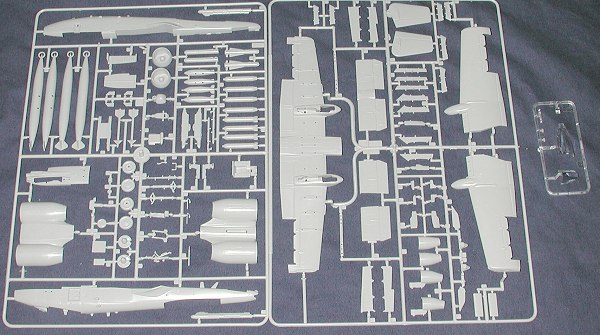
This is a much more modern Italeri kit than the F-18 I recently previewed. It has properly engraved panel lines and has gotten rid of most of the ejector pin marks. There are still a few on the nose gear leg, the inside of some gear doors, the Sidewinder launch rails, some of the weapons pylons, and on the bodies of the Sidewinder missiles, but otherwise it is much cleaner. No sink marks or flash, either. The canopy is not only crystal clear, but actually doesn't have t have the framework cut from the surrounding body to be displayed open. Cockpit is about the same with raised instrument detail and an OK bang seat.
What is really impressive is that this kit comes with a very nice ordnance load that includes Mavericks, Rockeyes, Mk 84 bombs, ECM pods and Sidewinder missiles. The large long-range fuel tanks are also included though the instructions only show one being used on the centerline. Other options are having the canopy open or closed, and the same with the boarding ladder. The aileron/speedbrakes can also be posed in the open or closed position. It should be no surprise that this beastie needs 30 grams of weight to keep it off its butt. I've been asked if this is an early or late plane. Well, it doesn't have the additional antennas on the nose or tail fins. I also realized that my kit has a short shot rear right fuselage half. It will be interesting to see if RoG is willing to supply a replacement.
Instructions are typical
newsprint quality RoG types with lots of construction pictures and the need to
mix nearly all the exterior camouflage colors because Revell paints don't have
common FS 595 colors in their inventory. Unfortunately, no FS numbers are given
on the painting and decal guide so that we can use our Humbrol or Testors or
Gunze paints. Two schemes are provided with this kit. One is the box art
aircraft from the 511th TFS/354th TFW During Destert Storm. This Alconbury based
aircraft is in the Lizard scheme of FS 36081, 34102 and 34092. The other
is a Spagdahlem, Germany based plane from the 510 FS/52 FW and marked as the 52
FW boss bird. It is in the greys scheme of FS 36320 and 36375. You can take a
look at the pics of the planes below to help you out. The Alconbury plane was
photographed in typical English weather (dreary) in March of 1991 after
returning from the Gulf. All sorts of data
markings are included as are missile and bomb markings. The decals are printed
in Italy and are of a very good quality. They even include decals for the
instrument panels should you decide you'd rather have those.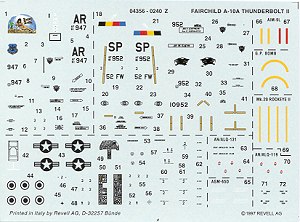
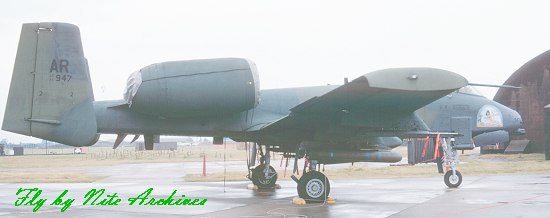
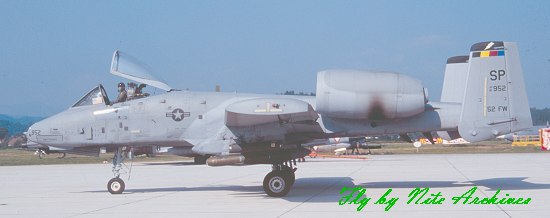
|
CONCLUSIONS |
I'd have to say that this is undoubtedly the best 1/72 A-10 on the market and much nicer than the older Hasegawa and even more ancient Monogram kit. If you want a great Hog kit, this would be the one!
If you would like your product reviewed fairly and fairly quickly by a site that has nearly 200,000 visitors a month, please contact me or see other details in the Note to Contributors.